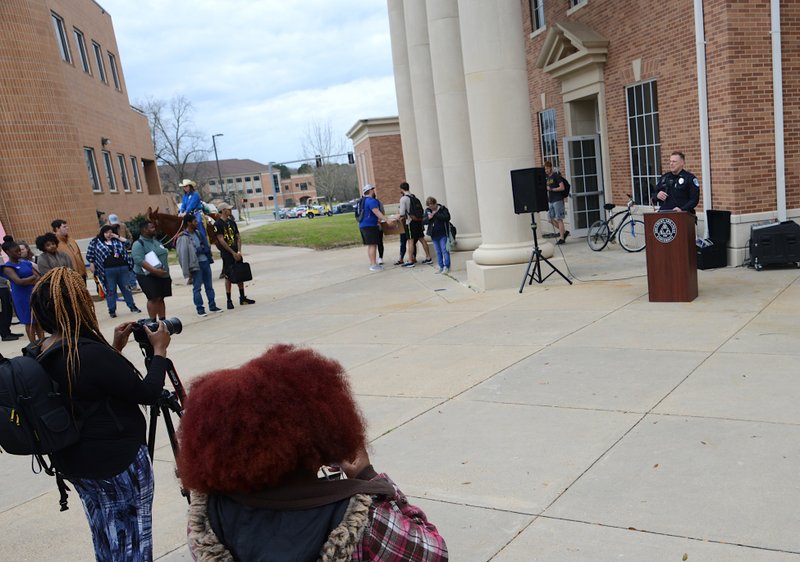As part of the state’s opioid and substance abuse awareness initiative, Southern Arkansas University this week held special speaking and information sessions to bring the addictive and sometimes deadly drug(s) to the forefront of students’ minds. On Tuesday, the event kicked off with speakers that included members of SAU staff and student government, as well as Magnolia city officials.
Opioids, or opium-derived pharmaceuticals and narcotics, range from prescribed painkillers such as hydrocodone, oxycodone, Vicodin, Percocet, demeral and morphine to ultra deadly and addictive drugs like heroin and fentanyl — a drug gaining popularity in America and one of the most deadly narcotics known at 50-100 times stronger than morphine, according to the CDC.
“Opioids are something that I don’t like seeing,” said Magnolia Police Officer Kenneth Stough. “…People take it to relax, but it will relax you a little much. Your heart rate goes down, then, if you go to a party and add alcohol on top of that – you’re lying on the ground not breathing.”
The only way to revive an overdosing opioid victim comes through the use of the opioid antagonist Narcan, or naloxone, nasal spray or injection.
“I have seen it first-hand and it’s not pleasant,” Stough added.
Many people now take opium-based drugs for more than just pain. The officer said opioids can lead people down a dangerous path of addiction and criminal acts.
“Taking hydrocodone and morphine and drugs like that — it’s not worth it,” he said.
The bad track the officer spoke of was further emphasized by another speaker. Juliana Williams, chief of staff for SAU’s Student Government Association, read a letter detailing the effects opioids had on a regular Magnolia resident and SAU staff member.
Written by an employee at the school’s student life office, a tale of pain, addiction, family dissolution, and, ultimately prison was told to those in attendance.
The letter stated that a long-term migraine headache led the author’s daughter in high school to visit numerous doctors where hydrocodone was always prescribed as a remedy. But withdrawing from the medication eventually led to more headaches between doses and a constant craving for the prescription pills.
“It took several weeks and a lot of pain, but she finally broke the addition,” Williams said as she read the letter.
Years later, a dental procedure led to another pain-relief prescription to hydrocodone and another bout with drugs.
“She didn’t think anything about it until she took the first dose,” the letter said. “That was all it took for the addiction to come back.”
The criminal acts then began. Money was borrowed to “pay bills,” then a stint as a caretaker for her grandmother led to far worse than just a simple spat between family members.
“We found out my daughter had been drawing money out of my mother-in-law’s life savings to buy drugs,” Williams read in the letter. “We immediately took her to a longterm rehab where she stayed for four months, then walked out.”
In the following two years, arrests were made and probation was issued. The drugs had been in play virtually the whole time, the letter said.
Even after probation sentencing, checks were stolen and forged — again from the grandmother — finally leading to more arrests and, finally, a two-year prison term for the employee’s daughter.
“Today, we have no relationship at all,” the letter said.
The purpose of the letter was to serve as a warning for anyone prescribed hydrocodone or any other opiate-based drug so the same fate does not fall upon another family.
“None of us know if we have an addictive personality,” Williams read in the letter’s closing remarks. “…Ask [the doctor] first if there is anything else you can take that is not an opioid – it can save your life.”
Numerous other events were scheduled this week as part of the opioid awareness initiative. On Thursday, a panel discussion was held between professional counselors and law enforcement, and the Arkansas Department of Health presented an information session to educate students on the dangers and habits of the drugs.
The drug overdose rate in the state is at an all-time high. From 2000-2016, average overdose deaths per 100,000 persons nearly tripled, from 5.4 per year to 14. The average age from overdosing deaths from 2014 to 2016 in Arkansas was 43. The overdose rate in Columbia County per 100,000 from 2010 to 2016 was between 9.7 and 13.6, annually.
Out of the 905 fatal overdose deaths in Arkansas, according to 2016 ADH statistics, 331 death certificates mentioned opioids. Some of the listed drug names included oxycodone, hydrocodone, methadone, and heroin.
In 2016, according to 2016 CDC statistics, 66 of the state’s 75 counties had opioid prescription rates higher than the national average.
“Opioids killed Elvis Presley,” said a presenter on Thursday. “They can kill you, too.”

